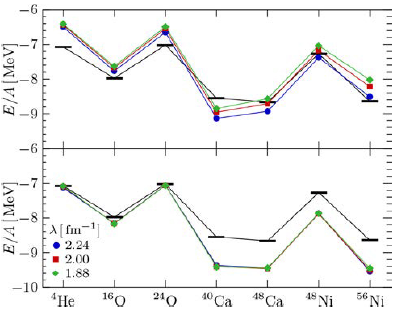
Professor of Physics
Joined the laboratory in 2007
Education and training
- PhD, Theoretical Physics, SUNY Stony Brook, 2002
Research focus
- Nuclear theory
Contact information
Links
Research
My research focuses on applications of renormalization group (RG) and effective field theory (EFT) methods to the microscopic description of nuclei and nuclear matter. EFT and RG methods have long enjoyed a prominent role in condensed matter and high energy theory due to their power of simplification for strongly interacting multi-scale systems. More recently, these complementary techniques have become widespread in low-energy nuclear physics, enabling the prospect for calculations of nuclear structure and reactions with controllable theoretical errors and providing a more tangible link to the underlying quantum chromodynamics.
The use of EFT and RG techniques substantially simplifies many-body calculations by restricting the necessary degrees of freedom to the energy scales of interest. In addition to extending the reach of ab-initio calculations by eliminating unnecessary degrees of freedom, many problems become amenable to simple perturbative treatments. Since a mean-field description now becomes a reasonable starting point for nuclei and nuclear matter, it becomes possible to provide a microscopic foundation for extremely successful (but largely phenomenological) methods such as the nuclear shell model and nuclear density functional theory (DFT) that are used to describe properties of the medium mass and heavy nuclei.

Biography
I was born and raised in Cincinnati, Ohio, the 4th (and only boy) of 5 kids. For the first 16 years of my life, I aspired to be a major league baseball player, a guitar player in a rock and roll band, or a historian. Physics wasn’t even a blip on my radar. This was primarily due to a miserable experience in my 7th grade AP math class that completely destroyed my enthusiasm for math and science. It wasn’t until my junior year in high school that my interest was re-kindled by a particularly talented and quirky physics teacher named Mrs. Clemens. From that point on, I knew I wanted to pursue a career in the physical sciences. As an undergraduate at the University of Cincinnati, I majored in Nuclear Engineering. While I enjoyed the engineering curriculum, I quickly realized that my favorite classes by far were the “pure” physics courses. Once I took Quantum Mechanics in my third year, my mind was made up—I wanted to be a theoretical physicist.
How students can contribute as part of my research team
My research program presents a diverse range of research opportunities for potential PhD students, encompassing three different (but interrelated) topics: 1) in-medium effective inter-nucleon interactions, 2) ab-initio methods for finite nuclei and infinite nuclear matter, and 3) density functional theory for nuclei. The nature of these topics requires a mixture of theoretical and computational developments, which gives students flexibility to tailor their PhD research to match their interests.
Scientific publications
- Nonempirical Interactions from the Nuclear Shell Model: An Update, S.R. Stroberg et al., Ann. Rev. Nucl. Part. Sci. 69, no. 1, (2019).
- Microscopically based energy density functionals for nuclei using the density matrix expansion, R. Navarro-Perez et al., Phys. Rev. C 97, 054304 (2018).
- Nonperturbative shell-model interactions from the inmedium similarity renormalization group, S.K. Bogner et al., Phys. Rev. Lett. 113, 142501 (2014).

